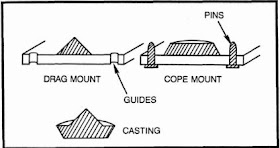 |
| schematic of match plate pattern |
Characteristics of Match Plate Pattern
- It is split pattern
- Cop and Drags on the opposite site of the metallic (generally) plate.
- The gates are runners are on the match plate.
- Can be used for large number of casting with very little hand work.
- A match plate can be single pattern or a combination of many small patterns
- Example : IC engine piston rings can be produced by match plate pattern
Important parts of Match Plate Patterns
Cope and Drag Mounts
- Two separate pattern mounts are there.
- One is fitted to the female guides (for drag) other is fitted with pins (for cope). This must match the profile of the flask that is used.
- The half part of the pattern associated by the cope is attached to the cope mount and drag part pattern is attached to the drag mount.
- Cope and drag portions are manufactured disparately and combined together for pouring.
- Generally one molder makes copes other makes drags.
- Cope and drag mounts are also known as tubes.
- These (cope and drag mounts) are very similar when producing large castings.
 |
| cope and drag mounts in match plate pattern |
Follow
board
- It is a board with a cavity or socket.
- The cavity must conform to the shape of the pattern.
- It also defines the parting surface of the drag.
- Materials: It can be made of plaster or metal. If sand is used to manufacture follow board then it is called dry sand match.
- When the drag half of the mold is made the pattern rests on the follow board.
- It creates the correct sand parting.
- Pattern is rammed in the drag and follow board is removed.
- The follow board is replaced by the cope.
- A simple follow board may have a hole in it so that the pattern rests firmly when the drag is being rammed.
 |
| follow board |
 |
| simple follow board |
- Different types of casting defects
- What is casting ? Main application of castings
- different types of patterns that are used on the sand casting process.
- different types of molding sand
- properties of various natural and synthetic molding sands
- Comparison of different casting processes.
- Advantages and disadvantages of centrifugal castings.
No comments:
Post a Comment